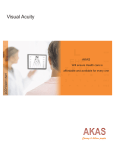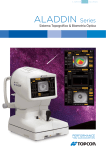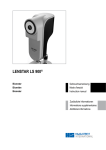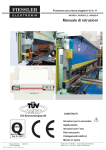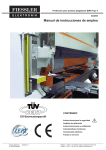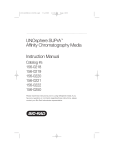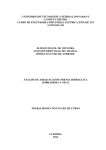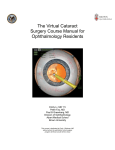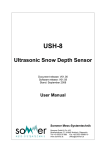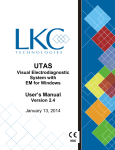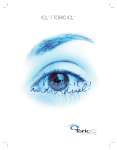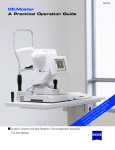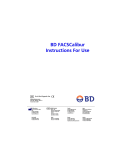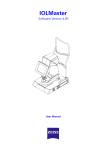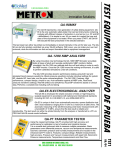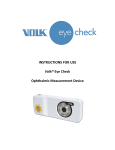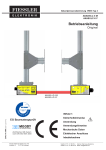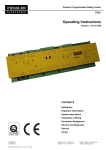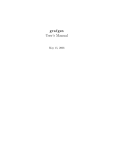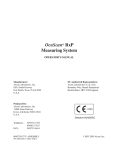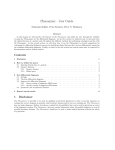Download ascan updated - Akas medical
Transcript
Bio Meter AKAS Will ensure Health care is A-scan affordable and available for every one Caring 6 billion people An Experience Innovation Affordable Global Solution Quality About AKAS Medical AKAS Medical was started in 1996 as a small firm with a team of professionals headed by Mr.Arjunsooraj.V, CEO. The techonology and product innovation is headed by Mr.Arunkrishna.V. The promoters are qualified engineers and Management graduates with shared Vision. AKAS started with manufacture of drug delivery systems and now has grown many folds in the field of Ophthalmology, Critical Care, Disposables, Nutrition, Online Medical stores (www.akasdoctor.com) Today AKAS Medical has its head office at Chennai in India and manufacturing plants and marketing offices at various locations globally. It has grown through sheer expertise and knowledge sharing in the field of medicine and technology. AKAS Medical other than following the ISO 9001 quality management system has itself developed a quality management system apt for the medical devices quality and has named it as “AKAS Quality System” (AQS in short). AKAS pays lot of importance on Safety on the therapeutic and diagnostic products that it manufactures. Today AKAS Products and solutions are accepted world wide by the medical fraternity. AKAS believes in being socially responsible and stand by its mission to make health care affordable and available for everyone. AKAS believes in not just selling products but in offering solutions on the whole and also in education of its customers to enhance their experience in availing AKAS products. What are the symptoms of cataracts? Early signs of cataracts include blurred or cloudy vision; frequent changes in eyeglass or contact lens prescriptions; night glare and hazy vision; and colors that seem to fade. An ophthalmologist must determine if these symptoms are really caused by a cataract or by some other eye problem that may need treatment. For an adult, a cataract should be removed only when it interferes with lifestyle and makes it difficult to continue normally enjoyable activities. Generally, there is no such thing as a cataract being "ripe" or "not ripe" for removal. What matters is whether or not the problem interferes with vision. In rare instances, a "hypermature" cataract may cause elevated eye pressure or inflammation of the eye. In this case, it must be removed immediately. Otherwise, removal of a cataract is at the patient's discretion What are the different types of cataracts? 1 Age-related cataract: Most cataracts are related to aging. 2 Congenital cataract: Some babies are born with cataracts or develop them in childhood, often in both eyes. These cataracts may not affect vision. If they do, they may need to be removed. 3 Secondary cataract: Cataracts are more likely to develop in people who have certain other health problems, such as diabetes. Also, cataracts are sometimes linked to steroid use. 4 Traumatic cataract: Cataracts can develop soon after an eye injury, or years later. A-Scan Biometry The axial length (AL) is conventionally measured with ultrasonography, using a biometry unit. Measurement of the AL is achieved using an immersion or a contact technique. It is always advisable to have both eyes measured for comparison purposes. Immersion A-Scan Biometry TECHNIQUE The technique described herein can be used with any ultrasound unit equipped with a solid A-scan probe and mobile electronic gates.1-4 1. The patient is placed in a supine position on a flat examination table or in a reclining examination chair and a drop of local anesthetic is instilled in both eyes. 2. A scleral shell is applied to the eye. The most commonly used scleral shells are the Hansen shells (Hansen Ophthalmic Development Laboratory, Coralville, IA) (Figure 10-1A) and the Prager shells (ESI, Inc., Plymouth, MN) (Figure 10- 1B). The Hansen shells are available in 16, 18, 20, 22 and 24 mm diameter. While the 20 mm shell fits most eyes, the larger cup provides a better fit in bigger eyes with large palpebral fissures and the smaller cups fit better in the presence of a narrow palpebral fissure. The newest Prager shell features single handed immersion biometry, a Luer fitting to facilitate tubing changes, an autostop for exact manufacturer specified probe depth, and six centering guides to ensure perpendicularity. Each shell is polished, allowing direct visualization of fluid levels. Other types of scleral shells are also available from different manufacturers including the Kohn shell (Innovative Imaging Inc., Sacramento, CA) (Figure 10-2). The Prager shell and the Kohn shell have made immersion biometry easier. The use of the Kohn shell is discussed in Chapter 11. In this section, we will describe the routine method used with the Hansen shells. 4 The Hansen shell is filled with gonioscopic solution. Methylcellulose 1% is preferred over the 2.5% concentration (too thick) and over saline solutions (too liquid). The solution should be free of air bubbles; the presence of bubbles causes variations in the speed of sound and is responsible for noise formation within the ultrasound pattern. The easiest way to avoid bubbles is to remove the bottle's nipple and to pour the solution in the cup (Figure 10-3). If bubbles do form within the solution, they are removed with a syringe, and, if unsuccessful, the cup has to be emptied, cleaned, repositioned, and refilled with gonioscopic solution. The Kohn shell is designed to hold the probe tightly and allow a better fit on the eye. Because of this tight fit, the coupling fluid used in this shell does not have to be methylcellulose; instead, balanced salt solution or artificial tears could be used. 5 The ultrasound probe is immersed in the solution, keeping it 5 to 10 mm away from the cornea (Figure 10-4). The patient is asked to look, with the fellow eye, at a fixation point placed at the ceiling. Attention is then focused on the screen. The probe is gently moved until it is properly aligned with the optical axis of the eye and an acceptable A-scan echogram is displayed on the screen. A-SCAN PATTERN OF THE PHAKIC EYE The A-scan pattern of a normal phakic eye examined with an immersion technique displays the following echospikes from left to right (Figure 10-5): The Kohn shell. The cup is placed between the lids and methylcellulose 1% is poured into the cup. The ultrasound probe is immersed in the solution, keeping it 5 to 10 mm away from the cornea. IS: The initial spike (IS) is produced at the tip of the probe. It has no clinical significance. Many units will allow the technician to move the whole Ascan pattern to the left and remove the IS from the picture (Figure 10-6). C: The corneal spike (C) is double peaked, representing the anterior (C1) and posterior (C2) surfaces of the cornea. L1: The anterior lens spike (L1) is generated from the anterior surface of the lens. L2: The posterior lens spike (L2) is generated from the posterior surface of the lens, and is usually smaller than L1. R: The retinal spike (R) is generated from the anterior surface of the retina. It is straight, high-reflective, and tall whenever the ultrasound beam is perpendicular to the retina, as it should be during AL measurement. S: The scleral spike (S) is another high-reflective spike generated from the scleral surface, right behind the retinal spike, and should not be confused with it. O: The orbital spikes (O) are low-reflective behind the scleral spike. The eye is divided ultrasonically into three compartments (See Figures 10-5 and 10-6): 5,6 1. The anterior chamber depth (ACD) is measured between the anterior corneal surface (C1) and 5 the anterior lens surface (L1) using a velocity of 1532 m/s. If needed, the corneal thickness is measured between the anterior (C1) and posterior (C2) surfaces of the cornea using a velocity of 1620 m/s. The thickness of a normal cornea is approximately 0.5 mm. 2. The lens thickness 7-12 is measured between the anterior lens surface (L1) and the posterior lens surface (L2) using a velocity of 1641 m/s. Actually 1640.5 m/s is the calculated sound velocity in the normal crystalline lens. The sound velocity varies in cataractous eyes with a slower velocity (average 1590 m/s) in the intumescent cataracts due to their high water content, and a higher velocity in the posterior capsular cataracts. In most cases of nuclear sclerosis with or without subcapsular changes, the sound velocity averages 1641 m/s. 6 3. The vitreous cavity's depth is measured between the posterior lens surface (L2) and the anterior surface of the retina (R) using a velocity of 1532 m/s. 13 A manual measurement of the axial length is used with older ultrasound units not equipped with an electronic read-out, and is rarely used nowadays. Using calipers, a measurement is taken from the scale in microseconds. However, this reading represents the travel time it takes the ultrasound beam to reach the tissue under examination and return to the probe, thus representing twice the actual measurement. It is then divided by 2, and converted to millimeters using an average velocity. Some biometers give the readings directly in millimeters using an average sound velocity. This velocity is reported in meters per second (m/s). Most biometers use an average velocity of 1550 to 1555 m/s. A velocity of 1553 m/s is recommended. 14 Most modern biometers use separate sound velocities for13the different eye components. The biometer provides an ACD, the lens thickness, and the total AL. Figure 10-5. Ultrasound display of the different echospikes during immersion biomet ry, identifying the initial spike (IS), the anterior (C1) and posterior (C2) corneal surfaces, the anterior (L1) and posterior (L2) lens surfaces, the retina (R), sclera (S), and orbital tissues (O). Figure 10-6. A-scan display of a phakic eye where the initial spike has been removed from the screen display and identifying the corneal (C1 & C2), lens (L1 & L2) and retinal (R) spikes. Contact A-Scan Biometry TECHNIQUE The contact technique for AL measurement is an alternative to immersion A-scan biometry. It does not use a scleral shell. Instead, the probe comes in contact with the cornea to generate the first echospike. 1. A drop of local anesthetic is instilled in both eyes. The patient is examined in the seated position, with the chin correctly positioned on a free-standing chin rest.15-17 2 . The ultrasound probe is attached to a zero-weight balance glide to prevent any pressure on the eye during examination. The probe's movements are controlled through a joystick handle (Figure 10-7). The probe is positioned in front of the eye and the patient is asked to fixate the red light within the probe. The probe is then brought forward to gently touch the cornea without indenting it. Figure 10-7. Contact A-scan biometry. The technician uses the joystick to align the probe with the patient’s eye. Figure 10-8. The small solid probe fits in the tonometer holder for A-scan biometry. 4. Attention is then focused on the screen. The probe is moved slightly, up and down or to the side to optimize the echospikes displayed on the oscilloscope. A Polaroid picture or a print-out is obtained. Other probes are mounted on a Goldmann tonometer holder and are designed to be used with a slitlamp (Figure 10-8). The examination is performed in the same manner as previously described. Handheld compact biometric rulers such as the Bio-Pen18 (Mentor O & O, Norwell, MA) have lost some of their popularity and are now rarely used. Probes used with the contact technique should be cleaned after each examination to prevent contamination. Figure 10-9. A-scan display of a phakic eye measured with contact A -scan biometry. Since the probe is in contact with the eye, the initial spike and the anterior corneal spike become one. A-SCAN PATTERN The A-scan pattern of a phakic eye examined with the contact technique (Figure 10-9) demonstrates similar echospikes, except that the corneal spike is merged with the initial spike since the cornea is in touch with the tip of the probe. Variations in Axial Length Measurement Variations in AL measurement are due to the use of different examination techniques and/or to the use of different sound velocities by the biometer. VARIATIONS DUE TO THE EXAMINATION TECHNIQUE The contact method for AL measurement does not yield the same results as the high precision A-scan biometry. When measuring the same eye, the contact technique yields a shorter measurement than the 18-21 21 immersion technique. In a prospective study on 180 eyes performed by the author, AL measurements were obtained on each eye with both contact and immersion techniques. Each eye was measured with the Ocuscan-DBR (contact) (Alcon, Irvine, CA), the Ocuscan-400 (immersion) (Alcon), and the Kretz 7200 MA (immersion) units. AL measurements obtained with the contact technique were shorter than measurements obtained with the immersion technique by an average of 0.24 mm. The two methods of examination differ in the patient's position and the possible corneal applanation by the ultrasound probe. The patient is conventionally examined in the seated position with the contact technique and the probe is brought forward to touch the cornea. The patient is conventionally examined in the supine position with the immersion technique and the solid probe is kept 5 mm to 10 mm away from the cornea. These differences in the methods of examination, mainly the corneal indentation and the subsequent shallowing of the anterior chamber, are responsible for the shorter measurement obtained with the contact technique. Figure 10 -10A. A- scan display of a phakic eye using immersion biometry. Figure 10 -10B. A -scan display of the same phakic eye using contact biometry. Note the shallower anterior chamber depth (ACD) and shorter axial length (AXL) with this technique. Clinical Application Figure 10-10 shows measurements obtained from the same eye with an immersion technique (Figure 10-10A) and a contact technique (Figure 10-10B). Note the shallower ACD (3.49 instead of 3.69 mm) and shorter AL (24.98 instead of 25.18 mm) obtained with the contact technique. Biometry Methods Explained. Routine A-scan biometry is an indispensable tool for ophthalmology, but has limitations in resolution and an inability to consistently direct the sound beam to a known location. And although we have accepted ultrasound-based biometry as our main methodology for the measurement of axial length, it's important to keep in mind exactly what we are doing. The resolution of a wavelength-based measurement is inversely proportional to the wavelength of the measuring device being used. The longer the wavelength the lower (worse) the resolution. The shorter the wavelength, the higher (better) the resolution. This is why an electron microscope has much higher resolution than a light microscope. This is also why we use 50-MHz ultrasound to more precisely image somewhat smaller anterior segment structures, rather than 10-MHz ultrasound. Things work best when the measuring wavelength is many times shorter than the distances being measured, or the resolution desired. Fundamental Principle #3: Variability for an on-axis A-scan measurement is an artifact of position. Here is an OCT-3 macular thickness plot from a normal eye that illustrates this. So, for the exercise of A-scan biometry, we have to take into account the inherent resolution limitations of a 10-MHz sound wave and its inability to discriminate between the foveal center and the foveal shoulder. This may not sound like a large error, but it's helpful to keep in mind that these types of errors are cumulative. Limited resolution. As mentioned above, a 10-MHz sound bean has a resolution of approximately 0.03 mm. By comparison, the 780-nm partially coherent light source used in optical coherence biometry has a wavelength of 0.0000000975 mm. And since the smaller the wavelength, the higher the resolution, there is simply no comparison between the two. Fundamental Principle #3: Variability for an on-axis A-scan measurement is an artifact of position. Here is an OCT-3 macular thickness plot from a normal eye that illustrates this. So, for the exercise of A-scan biometry, we have to take into account the inherent resolution limitations of a 10-MHz sound wave and its inability to discriminate between the foveal center and the foveal shoulder. This may not sound like a large error, but it's helpful to keep in mind that these types of errors are cumulative. Limited resolution. As mentioned above, a 10-MHz sound bean has a resolution of approximately 0.03 mm. By comparison, the 780-nm partially coherent light source used in optical coherence biometry has a wavelength of 0.0000000975 mm. And since the smaller the wavelength, the higher the resolution, there is simply no comparison between the two. The Haigis Formula. Intraocular Lens Power Calculations. IOL power calculations have become the main focal point of refractive surgery in a relatively short period of time. As recently as 1977, the state-of-the-art IOL power calculation to achieve emmetropia with a posterior chamber IOL, was simply adding +19.0 D to the pre-cataractous refraction. Around 1990, with the formulas available at that time, being within ±1.00 D of the target refraction was considered perfect. Today, by paying attention to IOL power calculations and advanced surgical techniques, it is possible to be within ±0.50 D in 95 percent of surgeries or better, and fast becoming the standard. 4-IOL Constants Here is a Microsoft Excel spreadsheet that can be used to calculate an average IOL constant based on data from 100 patients for the four popular IOL power formulas (Holladay 1, Hoffer Q, SRK II and SRK/T). Constants ~ 4-IOL Calculation Formulas One of the final frontiers in ophthalmology is the consistently accurate calculation of intraocular lens power for all eyes. When properly "personalized," any of the modern IOL power calculation formulas will do a good job for normal axial lengths and normal central corneal powers. However, for very long or short eyes, or for eyes with very flat or very steep corneal powers, consistently accurate IOL power calculation has remained elusive. Dr. Wolfgang Haigis Haigis Holladay Holladay SRK/T Hoffer Q a0, a1 & 1 2 AACD a2 SF ACD constant optimized optimized optimized optimized optimized AL in mm Haigis only a0 optimized 18.00 - 19.99 0.50 D 0.50 D 0.50 D 1.00 D 0.50 D 2.00 D 20.00 - 21.99 0.25 D 0.25 D 0.25 D 0.50 D 0.25 D 1.00 D 22.00 - 25.99 0.25 D 0.25 D 0.25 D 0.25 D 0.25 D 0.25 D 26.00 - 27.99 0.25 D 0.25 D 0.50 D 0.25 D 0.25 D 0.25 D 28.00 - 30.00 0.50 D 0.25 D 0.50 D 0.25 D 0.25 D 0.50 D Minus power IOLs 1.00 D 0.50 D 1.00 D 0.50 D 0.50 D 1.00 D The chart above represents our experience with several popular posterior chamber intraocular lenses with axial length measured using the IOLMaster, with results displayed in terms of the best possible mean absolute prediction error. These data represent outcomes for patients with keratometry below 50.0 D and above 40.0 D and excludes cases of keratoconus, or prior keratorefractive surgery. For the reasons outlined above, your own individual results may vary, depending on the geometry of the intraocular lens used and overall accuracy of pre-operative measurements, such as keratometry, ACD and axial length. Applanation A-scan Biometry. A-scan biometry by applanation requires that the ultrasound probe be placed directly on the corneal surface. This can either be done at the slit lamp, or by holding the ultrasound probe by hand. Even in the most experienced hands, some compression of the cornea is unavoidable; this typically being 0.14 mm - 0.28 mm. The popularity of the applanation method is due to how quickly it appears to be accomplished. Figure A - Phakic axial length measurement using the applanation method. a: Initial spike (probe tip and cornea) b: Anterior lens capsule c: Posterior lens capsule d: Retina e: Sclera f: Orbital fat Figure B - Note the typical applanation measurement variations. Measurements taken by applanation method will frequently show variability from one to the next, as a result of inconsistent corneal compression, and will be seen even under the most experienced guidance. The way to avoid this is to change to the immersion technique, as described below. For further reading, we highly recommend the book A-scan Axial Length Measurements by Sandra Frazier Byrne. Also, there is an excellent, national certification program in Ophthalmic Biometry available for your technicians: Immersion A-scan Biometry. Preferred over applanation: With the immersion A-scan technique, the probe tip does not come into contact with the cornea. Figure C - Break-down of phakic axial length measurements using the immersion technique. Instead, the ultrasound beam is coupled to the eye through fluid. Because there is no corneal compression, the displayed result more closely represents the true axial length. Note:Be sure to set your ultrasound machine to immersion mode, if it doesn't automatically do so, or you will get meaningless readings that are several mm too long. a: Probe tip. Echo from tip of probe, now moved away from the cornea and has become visible. b: Cornea. Double-peaked echo will show both the anterior and posterior surfaces. c: Anterior lens capsule. d: Posterior lens capsule. e: Retina. This echo needs to have sharp 90 degree take-off from the baseline. f: Sclera. g: Orbital fat. The immersion technique requires the use of a Prager Scleral Shell (pictured at the top of this page), or a set of Ossoinig or Hansen Scleral Shells. The patient lies supine, looking up at the ceiling and the scleral shell is placed between the eyelids and centered over the cornea. The scleral shell is then filled with a 40-60 mixture of Goniosol and Dacriose and the probe tip is placed into the solution. Align the ultrasound beam with the macula by having the patient look at the probe tip fixation light, then simply take your readings as usual. In our office we have found that the Prager Scleral Shell is easiest to use, and gives very consistent readings. The Prager Scleral Shell can be obtained directly from: A set of Ossoinig Scleral Shells, which are lighter in weight, easing probe manipulation, can be obtained from Hansen Ophthalmic Development Laboratories at (319) 338-1285. When the ultrasound beam is properly aligned with the center of the macula, all five spikes (cornea, anterior and posterior lens capsule, retina and sclera) will be steeply rising and of maximum height. Changing to this technique is an important first step in improving the overall accuracy of your A-scans. Measurement consistency from one measurement to the next is often outstanding, due to the lack of corneal compression and the fixed position of the ultrasound probe over the surface of the cornea. AKAS Bioscale al e AKAS Biosc Diagnosis Measurement Modes: Contact Immersion Six Formulae SRK - I SRK - II Hoffer - Q BINK HORST HOLA DAY HAGIS Latest FPGA Technology - for fastest readings Aesthetics Slim and Portable Light weight model User friendly Color Touch Screen Display Built in Thermal Printer Packing content AKAS Bioscale Immersion cups Calibration cylinder Probe A scan Stylus (A scan) Thermal Paper (5 rolls) - A scan Power Chord 1no AKAS Bioscale A-scan User manual 1 no AKAS MEDICAL No.240/1, Periya colony, Athipet, Chennai-600 058. Tel: +91-44-32533333 / 98840 79116 Fax: +91-44-26350030 E-mail: [email protected] www.akasmedical.com R10 Product code : OPH OPD ATABIO Specification Clinical Accuracy : MEASUREMENT & IOL CALCULATION ID : 000000 Date : 000000 Patient : 000000 Doctor : 000000 New enhanced algorithms for rapid measurement 5 measurements presented on a single screen Multiple velocities and lens type for greater accuracy Statistical analysis of axial length, vitreous, anterior Chamber depth and lens thickness Continuous and manual readings OD : ( RIGHT) K1 42.00 D LENS : CATARACT K2 42.50 D GAIN : 70% MODE : CONTINOUS LT AC AL 4 - 07 4 - 01 4 - 01 4 - 01 3 - 96 3 - 96 3 - 96 4 - 01 3 - 96 4 - 07 3 - 61 3 - 61 3 - 61 3 - 61 3 - 61 3 - 61 3 - 61 3 - 65 3 - 61 3 - 61 21 - 69 21 - 69 21 - 69 21 - 69 21 - 69 21 - 69 21 - 69 21 - 69 21 - 69 21 - 69 AVG : STD : 3 - 61 D - 01 21 - 69 0 - 00 Data analysis : Edit scan data to IOL power calculations ALL current generation IOL power calculation formulae View multiple power calculations using different formulae in a single screen Transducer : Frequency 10MHz +/- 10% Clinical accuracy (+1/-) 0.1 mm Theoretical accuracy (+/-) 0.05 mm Axial length 15 - 40 mm Gain range 90db Fixation light internal fixation RED Measurement modes Contact Immersion 10 L CALACULATION Formula : Const : SRK-II 118.50 (A) IOL 26 - 50 27 - 00 27 - 50 28 - 00 28 - 50 REF +0 - 60 +0 - 20 - 0 - 20 - 0 - 60 - 1 - 00 HAGIS 118.50 (A) IOL 30 - 50 31 - 00 31 - 50 32 - 00 32 - 50 REF +0 - 72 +0 - 36 +0 - 03 - 0 - 32 - 0 - 68 IOL Power calculation formulas : SRK T, Binkhort SRK II, Hoffer Q Holladay Eye Modes : Phakic Aphakic Pseudo Phakic Auto and Manual Readings. Clinical Accuracy: +/- 0.1mm. Internal Fixation Light (Red). Freeze: Foot Pedal or Console. World wide Customer support We have well knit service network across the globe at Strategic locations. Our Service engineers undergo AKAS in-plant training course to enable quick and right support on field. Our customer care team is always available to clarify your queries on products and its operations or training as and when required. We constantly take up feed back from customers to evaluate our product performance and service support. Contact ... : +91-98840 79116 Tel : +91-44-3253 3333 Fax : +91-44-2635 0030 Cel [email protected] Global Support Genuine AKAS Spares Swift Online Support Enhanced Product Life Reduced Down Time Service support Contact number is stuck on the rear side of the equipment for immediate reference. Service Directly from the Manufacturers desk Factory trained Service engineers Genuine Spares at economical Prices – from manufacturer’s desk Genuine Spares available on demand CRM software for complaints registration and follow up Ordering information Please email for quote to [email protected] with the following information First name, Surname* Title Company Position/Department Address* Telephone Fax E-mail* AKAS Medical 240/1, Periya colony, Athipet, Ambattur, Chennai- 600 058. www.akasmedical.com : +91-98403 79116 Tel : +91-44-3253 3333 Fax : +91-44-2635 0030 [email protected] Cel Ascan/PDF/Mar 09 Caring 6 billion people

























